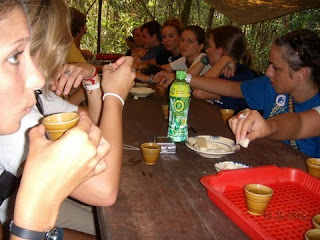Cu Chi, located about two hours from Ho Chi Minh City, is famous for its 200 kilometers (120 miles) of underground tunnels, dug and used by the Viet Cong during wars against both the French and Americans. The Viet Cong launched strategic attacks and then disappeared into the well-hidden tunnels.

On our way to the tunnels, we passed billboards, urging people to support the Communist Party. Our tour guide told us that people feel less need to be party members these days. In the past, when there were many state-run businesses, some applied for party membership to advance their careers. Today, most businesses are privatized and party membership is less important. As we drove toward the tunnels, we encountered heavy traffic – indicative of Vietnam's economic growth. The traffic consists mainly of motorbikes –expensive ones made in Japan while a type costing about $300 comes from China. "There are continuous traffic jams," our guide noted.
The Cu Chi Tunnels are a major tourist attraction here. As we arrived, Australian and Korean groups were being given tours. A young man from Hanoi briefed us. The tunnels were connected to wells, trenches and firing positions, and they extended to the Saigon River. 
Unknowingly, the Americans built a base camp on top of one of the tunnels, giving the Viet Cong many ambush opportunities. They used this section as their headquarters since they knew the camp was safe from American B-52 bombing.
The tunnels had three levels, at depths of 3 meters, 6 meters, and 8 to 10 meters, sufficiently deep that they could withstand the weight of tanks and the impact of most bombs. The tunnels included hundreds of air vents. Bamboo poles were driven through the ground into the tunnel and termites would infest these poles. As the termites consumed the bamboo, they created air passages allowing ventilation for the tunnel.
Our tour was uncomfortable, even jarring, for me and others, since it described history from the Viet Cong perspective. Our guide noted the exploits of a special "hero girl" who had killed more Americans than any other guerilla fighter. The tour included an exhibition of the various booby traps that the Viet Cong constructed and a mural showing the effects of each device on the American soldier who triggered it. 
The Cu Chi Tunnel complex is a kind of "Viet Cong Land" (parallel in form and function to Disneyland). The exhibitions are designed to entertain while showing what life was like in the tunnels during the "American War."
We were encouraged to crawl through a section of a tunnel, which was enlarged so that Western-size people could pass through. Many students were uncomfortable in the darkness and heat – crawling in the confining environment was unpleasant and exhausting.
Our guide described the strategies used by the Viet Cong as the war progressed. American troops attempted to flood the tunnels with water. Because passages were connected to the Saigon River, the system drained without problem. The Americans directed Filipino soldiers, who are a similar size to the Vietnamese, to crawl through the passages to find the Viet Cong. 
During a break in our tour, we sat at long wooden tables and were offered tapioca and tea.
As the war progressed, the American forces gained control of the tunnels. They killed 10,000 of the 16,000 Viet Cong in Cu Chi. Our tour guide did not mention that the tunnels eventually ceased to be a threat to American troops. Although the tunnels were eventually neutralized, the cost in lives was high. Our guide noted precise figures of how many Americans were killed during each of various campaigns. Both sides spent so much blood and money! The Americans were trying to thwart the spread of Communism and failed. The Vietnamese sought to reduce American influence. They experienced terrible deprivation and starvation after the war ended. Today, the Communist government is allowing globalization to shape Vietnam; so it seems that capitalism has triumphed. One might wonder why both sides thought it so necessary to fight?



1 comment:
Jim,
One can only image the emotional impact this part of the trip is having on you. I pray that you can share with these students the long lasting impact that war has on everyone involved.
Rhonda V.
Post a Comment